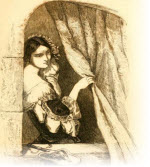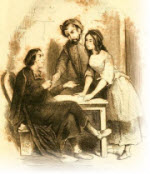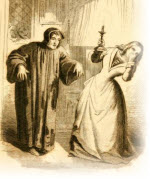
Boccaccio Decameron
There is indeed in Boccaccio’s description of the plague that which convicts it of pure invention, quickened by details gathered from eye-witnesses, — the very minuteness of the description in certain points not in accord with the character of the disease, as when he narrates that the hogs rooting in the garments of the dead thrown out into the streets "presently, as if they had taken poison, after a few dizzy turns, fell dead"; and this, which he says he saw with his own eyes, is the only incident of which he makes this declaration (the incident on which the unity of his work hinges, the meeting of the merry troupe in the church of S. Maria Novella, being recorded on the information of a person "worthy of belief"). Nor does he in his own person intrude anywhere in the story; so that this bit of intense realization thrown into the near foreground of his picture, as it were by chance, and without meaning, yet certified by his own signature, is the point at which he gets touch of his reader and convinces him of actuality throughout the romance.
And to my mind this opening chapter, with all its horrors and charnel-house realization, its slight and suggestive delineation of character, all grace and beauty springing out of the chaos and social dissolution, is not only the best part of the work, but the best of Boccaccio’s. The well-spun golden cord on which the "Novelle" are strung is ornamented, as it were, at the divisions of the days by little cameos of crafty design; but the opening, the portico of this hundred-chambered palace of art, has its own proportions and design, and may be taken and studied alone. Nothing can, it seems to me, better convey the idea of the death-stricken city, "the surpassing city of Florence, beyond every other in Italy most beautiful," — a touch to enhance the depth of his shade, than the way he brings out in broad traits the greatness of the doom: setting in the heavens that consuming sun; the paralysis of the panic; the avarice of men not daunted by death; the helplessness of all flesh before —
"the just wrath of God for our correction sent upon men; for healing of such maladies neither counsel of physician nor virtue of any medicine whatever seemed to avail or have any effect—even as if nature could not endure this suffering or the ignorance of the medical attendants (of whom, besides regular physicians, there was a very great number, both men and women, who had never had any medical education whatever), who could discover no cause for the malady and therefore no appropriate remedy, so that not only very few recovered, but almost every one attacked died by the third day after the appearance of the above-noted signs, some sooner and some later, and mostly without any fever or violent symptoms. And this pestilence was of so much greater extent that by merely communicating with the sick the well were attacked, just as fire spreads to dry or oiled matter which approaches it. Of the common people, and perhaps in great part of the middle classes, the situation was far more miserable, as they, either through hope of escaping the contagion or poverty, mostly kept to their houses and sickened by thousands a day, and not being aided or attended in any respect, almost without exception died. And many there were who ended their lives in the public streets by day or night, and many who, dying in their houses, were only discovered by the stench of their dead bodies; and of these and others that died everywhere the city was full.
These were mainly disposed of in the same way by their neighbors, moved more by the fear that the corruption of the dead bodies should harm them than by any charity for the deceased. They by themselves or with the aid of bearers, when they could find any, dragged out of their houses the bodies of those who had died, and laid them before the doors, where, especially in the morning, whoever went about the streets could have seen them without number,—even to that point had matters come that no more was thought of men dying than we think of goats; more than a hundred thousand human beings are believed to have been taken from life within the walls of Florence, which before the mortal pestilence were not believed to have contained so many souls. Oh! how many great palaces, how many beautiful houses, how many noble dwellings, once full of domestics, of gentlemen and ladies, became empty even to the last servant! How many historical families, how many immense estates, what prodigious riches remained without heirs! How many brave men, how many beautiful women, how many gay youths whom not only we, but Galen, Hippocrates, or Esculapius would have pronounced in excellent health, in the morning dined with their relatives, companions! and friends, and the coming night supped with those who had passed away."
The ten companions, meeting in the church of S. Maria Novella, seven ladies and three gentlemen, agree to escape this doom, and, repairing to one of the deserted villas in the neighborhood, to pass the time of affliction in merry doings and sayings; and with four maids and three men-servants, move eastward out of the gloomy city. Their first habitation is clearly indicated as what is known; to-day as the Poggio Gherardi, under Maiano. After the second day they return towards the city a short distance and establish themselves in what seems a more commodious abode, and which I consider incontrovertibly identified as the Villa Pasolini, or Rasponi, and which was in their day the property of the Memmi family, the famous pupils of Giotto. The site of this villa overlooks the Valley of the Ladies, which figures in the framework of the "Novelle," and in which then there was a lake to which Boccaccio alludes, now filled up by the alluvium of the Affrico, the author’s beloved river, and which runs through the valley and under the villa. The valley now forms part of the estate of Professor Willard Fiske. As the entire adventure is imaginary, and the "merry company" had no existence except in the dreams of Boccaccio, it is useless to seek any evidence of actual occupation; but the care he put in the description of the localities and surroundings, distances, etc., shows that he must have had in his mind, as the framework of the story, these two localities. The modern tradition ascribing to the Villa Palmieri the honor of the second habitation has no confirmation of any kind.
Advertisements:



Site Updates | Privacy Policy | Site Map | About
This is a website about the Decameron.